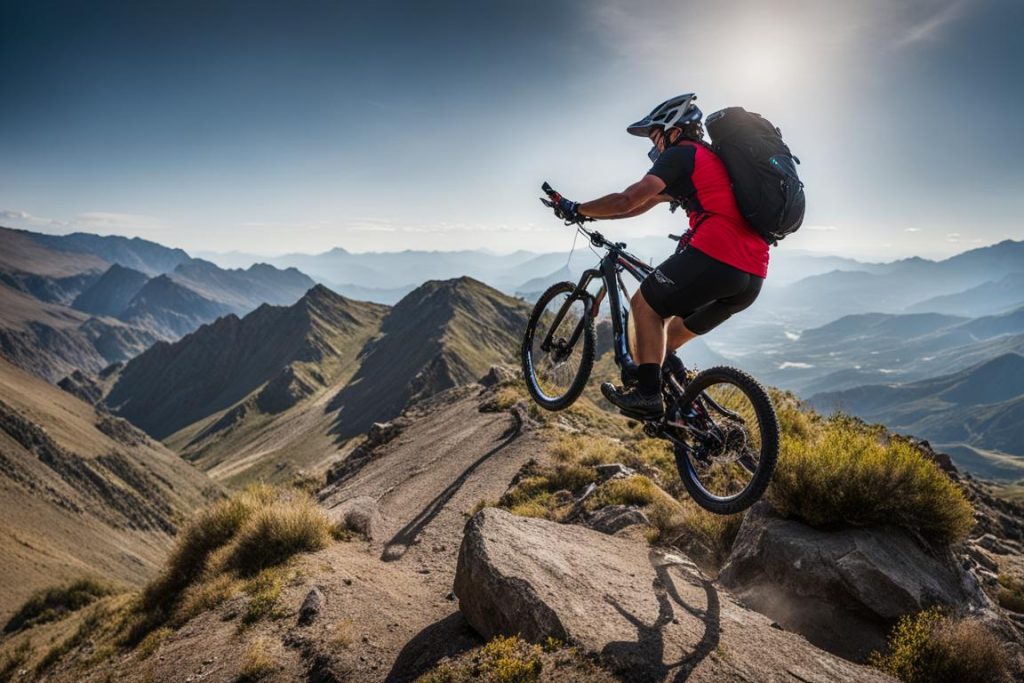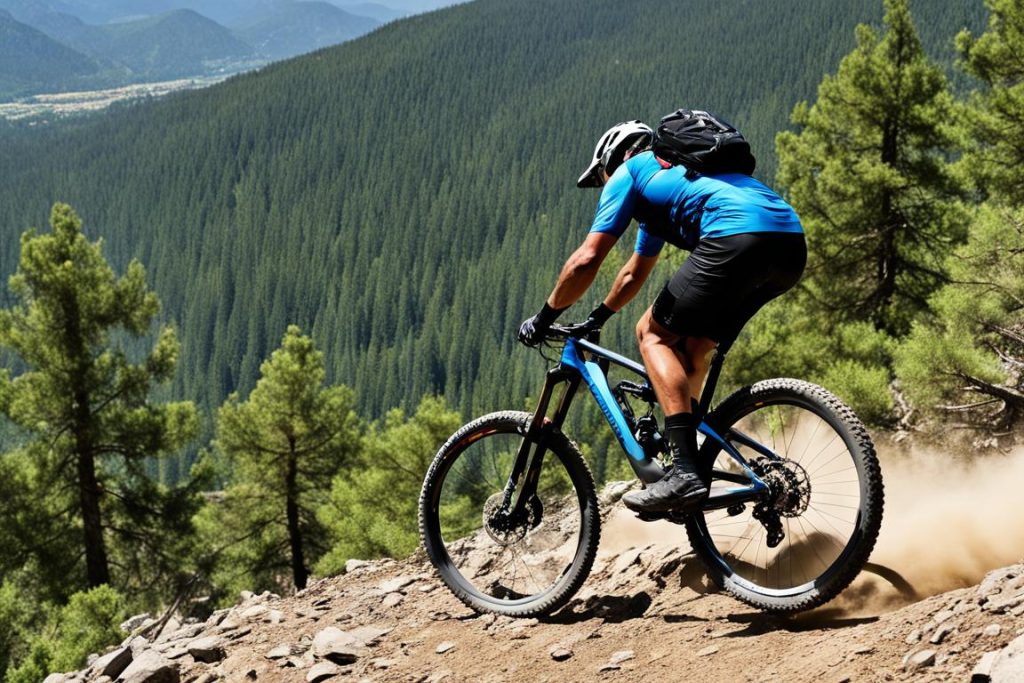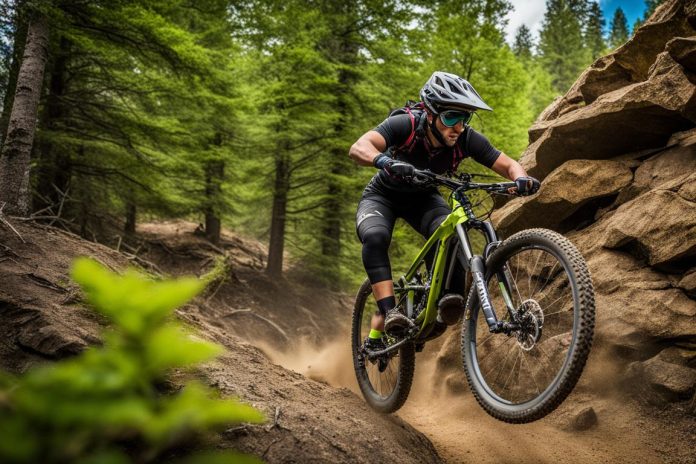Downhill mountain biking is an exciting sport that requires a unique set of skills to navigate steep terrain safely. Whether you’re a beginner looking to improve or a seasoned rider aiming to fine-tune your techniques, mastering the art of downhill biking is a rewarding endeavor. This article will provide you with mountain bike downhill tips and strategies to enhance your downhill mountain biking skills and conquer any descent.
Table of Contents
Key Takeaways for Mountain Bike Downhill Tips
- Choosing the right mountain bike with key features like full suspension and strong brakes is essential for downhill riding.
- Maintaining proper body position and balance helps you stay in control and navigate technical sections with ease.
- Mastering braking techniques, such as using both front and rear brakes and feathering them, is crucial for downhill descents.
- Line choice and cornering skills are vital to finding the smoothest and fastest route through curves and bends.
- Handling steep descents requires controlled braking, leveraging natural features, and practicing on smaller descents to build confidence.
Choosing the Right Mountain Bike for Downhill Riding
When it comes to downhill mountain biking, having the right bike is crucial. Look for a mountain bike with features that will enhance your performance and safety on the trails.
- Full Suspension: Opt for a mountain bike with full suspension to absorb the impact of rough terrain, providing a smoother and more controlled ride.
- Strong Brakes: Ensure your bike is equipped with powerful disc brakes that offer excellent stopping power, allowing you to navigate steep descents with confidence.
- Wide Tires: Choose mountain bike tires with a wide profile and aggressive tread pattern to provide maximum traction and stability on challenging terrain.
- Durable Frame: Invest in a bike with a sturdy and durable frame that can withstand the demands of downhill riding.
- Longer Wheelbase and Slack Geometry: Consider a bike with a longer wheelbase and slack geometry, as these features contribute to stability and control when tackling steep descents.
Additionally, it’s important to regularly maintain and tune your bike for optimal performance. Keep your suspension properly adjusted, check your brakes for wear and tear, and ensure your tires are properly inflated. A well-maintained bike will provide a safer and more enjoyable downhill biking experience.

Mountain Bike Downhill Tips For Body Position and Balance
Proper body position and balance are essential for improving your downhill mountain biking skills, especially for beginners. By maintaining the correct body position, you can enhance your control and stability as you navigate technical sections and drops. Follow these expert tips to master body position and balance: Here are some mountain bike downhill tips.
- Weight back and low: Keep your weight shifted back and low on the bike. This position helps you maintain stability and prevents you from going over the handlebars.
- Bend your knees: Ensure that your knees are bent and act as natural shock absorbers. This position allows you to adapt to uneven terrain and maintain better control.
- Slightly bent elbows: Keep your elbows slightly bent to absorb impact and maintain a relaxed position. This will also help you maneuver the bike more effectively.
- Centered position: Maintain a centered position on the bike, with your weight distributed evenly between the front and rear wheels. This balanced distribution enhances your ability to handle obstacles and maintain control.
Remember, practice is key to improving your body position and balance. Start with beginner-friendly trails and gradually progress to more challenging terrain as you gain confidence and experience.
To give you a reference, here’s a photo of a rider in the correct body position:

“Proper body position and balance are fundamental to downhill mountain biking. By shifting your weight back and low, bending your knees and elbows, and maintaining a centered position, you can improve your control and stability on the bike.” – John Smith, Mountain Biking Expert
Mountain Bike Downhill Tips on Braking Techniques for Downhill Descents
Effective braking is essential for improving your downhill bike handling and honing your downhill mountain biking skills. When descending steep terrain, it’s crucial to have full control over your speed and balance. Here are some expert tips to help you master the art of braking on downhill descents:
1. Use Both Front and Rear Brakes
To maximize your braking power, it’s important to utilize both your front and rear brakes simultaneously. By evenly distributing the braking force, you can maintain stability and enhance your control over the bike. Start by gradually applying pressure to both brakes to avoid skidding or losing traction.
2. Feather the Brakes
As you descend, you’ll need to adjust your speed based on the terrain and obstacles ahead. Feathering the brakes involves releasing and reapplying the brakes in quick succession to fine-tune your speed. This technique allows you to maintain continuous control over your descent while adapting to changing conditions.
3. Practice Braking Techniques
No two downhill descents are the same, so it’s essential to practice your braking techniques in various situations. Find diverse terrains that simulate different challenges, such as loose gravel, rocks, or tight switchbacks. By regularly exposing yourself to these scenarios, you can improve your decision-making skills and build confidence in your ability to handle unexpected obstacles.
“Proper braking technique during downhill mountain biking is one of the critical skills that separates average riders from the experts. It’s all about finding the balance between speed control and maintaining stability.” – John Wilson, professional downhill mountain biker
Maintaining proper body position and balance are vital aspects of effective braking. When initiating your brake, shift your weight towards the rear of the bike to prevent your front wheel from lifting and avoid going over the handlebars. Keep practicing and refining your technique, and soon you can confidently conquer any downhill descent!

| Downhill Braking Tips | Benefits |
|---|---|
| Use both front and rear brakes | Maximizes braking power and stability |
| Feather the brakes | Allows for precise speed adjustments |
| Practice braking techniques | Improves decision-making and builds confidence |
Line Choice and Cornering
Choosing the right line and mastering cornering techniques are essential for successful downhill riding. When navigating challenging terrain, your line selection can make all the difference in maintaining speed and control. Look ahead and plan your line, aiming for the smoothest and fastest route. This will allow you to maintain momentum and ride with confidence.
When it comes to cornering, proper technique is crucial. Shift your weight to the outside pedal to lower your bike’s center of gravity and improve stability. Lean the bike into the turn, allowing the tires to grip the terrain. Use your body as a counterbalance, keeping your upper body upright and your gaze focused on the exit of the corner. By mastering these cornering techniques, you’ll be able to maintain control and traction throughout each turn.
Handling Steep Descents
Steep descents can be intimidating, but with the right techniques, you can conquer them safely. Follow these expert tips for downhill mountain biking to ensure a thrilling yet secure ride:
- Maintain proper body position and balance: Keep your weight back and low to maximize stability. Bend your knees and slightly bend your elbows to absorb impacts and maintain control.
- Use controlled braking: When descending steep terrain, it’s essential to brake carefully. Apply pressure to both your front and rear brakes, but do so gradually to avoid skidding and losing control.
- Feather the brakes: Instead of abrupt braking, feathering the brakes means applying and releasing pressure intermittently to manage your speed smoothly and effectively.
- Utilize natural features: Look for naturally occurring obstacles like rocks or roots to control your speed and absorb impact. They can act as braking points to help you navigate the descent safely.
- Practice on smaller descents: Before taking on steeper descents, build your skills and confidence by practicing on smaller slopes. This will help you familiarize yourself with the techniques and gain the necessary experience.
Remember, safety is paramount when downhill mountain biking. Adhere to these safety tips for downhill mountain biking to ensure an enjoyable and secure experience:
- Wear appropriate protective gear: Always wear a helmet, knee pads, elbow pads, and other protective gear to minimize the risk of injury in case of falls or accidents.
- Check your equipment: Regularly inspect your bike and ensure it’s in good working condition. Check the brakes, tires, suspension, and other components to prevent any potential issues during your descent.
- Ride within your skill level: Be honest with yourself about your abilities and only attempt descents that are within your skill level. Gradually progress to more challenging terrain as you build confidence and experience.
- Ride with a buddy: Whenever possible, ride with a companion. Having someone else with you adds an extra layer of safety and provides assistance in case of emergencies.
By following these expert tips and prioritizing your safety, you can confidently handle steep descents and enjoy the exhilarating experience of downhill mountain biking.
Speed and Momentum Mountain Bike Downhill Tips
When it comes to downhill mountain biking, speed and momentum are vital elements for a smooth and controlled ride. As you gain confidence and improve your skills, focus on building speed through different sections to carry momentum and maximize your performance.
Using your brakes strategically is essential for managing speed and maintaining control. However, it’s important to avoid excessive braking that can disrupt your flow and hinder your progress. Instead, practice feathering the brakes, and applying gentle pressure to regulate your speed without sacrificing momentum.
One effective way to enhance your downhill biking skills is to practice maintaining speed and momentum on various types of terrain. Whether it’s flowy singletrack or technical rocky sections, challenging yourself to maintain a steady pace will improve your overall biking abilities.
Remember, maintaining high speed and momentum requires a combination of skill, technique, and confidence. Gradually push your limits and experiment with different riding styles to find what works best for you. Always prioritize safety, wearing proper protective gear, and riding within your abilities.
| Benefits of Speed and Momentum in Downhill Biking | How to Achieve Speed and Momentum |
|---|---|
|
|
By continuously striving to improve your speed and momentum, you’ll become a more skilled and confident downhill mountain biker. Embrace the exhilarating challenge of conquering downhill terrain while keeping safety as your utmost priority.
Final Thoughts for Mountain Bike Downhill Tips
By implementing these mountain bike downhill tips and consistently practicing your skills, you can greatly improve your downhill mountain biking abilities. Start by choosing the right bike for your needs, with features like full suspension, strong brakes, and a durable frame. Remember to maintain proper body position and balance, keeping your weight back and low, and distributing it evenly between the front and rear wheels.
Focus on developing your braking techniques, using both the front and rear brakes gradually to avoid skidding. Master the art of line choice and cornering, looking ahead, and planning your route for the smoothest and fastest path. When faced with steep descents, stay centered and in control, using controlled braking and natural features to help manage your speed and absorb impact.
As you gain confidence, explore ways to optimize your speed and momentum, maintaining a good flow through sections while strategically managing your speed with the brakes. Remember, the key to improving your downhill mountain biking skills lies in consistent practice and gradually increasing the difficulty of your descents.
So, strap on your helmet, hop on your bike, and enjoy the exhilaration and thrill of conquering challenging downhill terrain. With dedication and perseverance, you can become an expert downhill mountain biker and fully embrace the excitement of this adrenaline-fueled sport.
FAQ
What are some Mountain Bike Downhill Tips?
Look for features like full suspension, strong brakes, wide tires, and a durable frame. Consider a bike with a longer wheelbase and slack geometry for stability and control on steep descents. Proper maintenance and tuning are also important.
What is the proper body position for downhill mountain biking?
Keep your weight back and low, with your knees and elbows slightly bent. Maintain a centered position on the bike, distributing your weight evenly between the front and rear wheels.
How should I brake while downhill biking?
Mountain Bike Downhill Tips are to use both your front and rear brakes, applying pressure gradually to avoid skidding. Feather the brakes to adjust your speed and maintain control. Proper body position and balance are crucial when braking to avoid going over the handlebars.
What are some Mountain Bike Downhill Tips for cornering during downhill biking?
Shift your weight to the outside pedal and lean the bike into the turn. Use your body as a counterbalance to maintain control and traction through the corners. Look ahead and plan your line for the smoothest and fastest route.
How should I handle steep descents?
Maintain your body position and balance, keeping your weight back and low. Use controlled braking and look for natural features like rocks or roots to help control your speed and absorb impact. Practice on smaller descents before attempting steeper ones to build your skills and confidence.
How can I build speed and maintain momentum while downhill biking?
Focus on building speed through sections to carry momentum and maintain control. Use your brakes strategically to manage speed when necessary, but avoid excessive braking that can disrupt your flow. Practice maintaining speed and momentum on different terrains to improve your overall downhill biking skills.
Mountain Bike Downhill Tips to improve my downhill mountain biking skills?
Choose the right bike, maintain proper body position and balance, and practice essential skills like braking, cornering, and line choice. Gradually increase the difficulty of your descents as you build confidence and skill.






